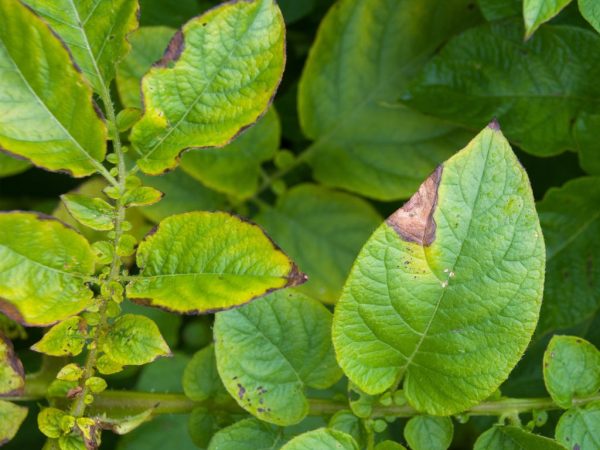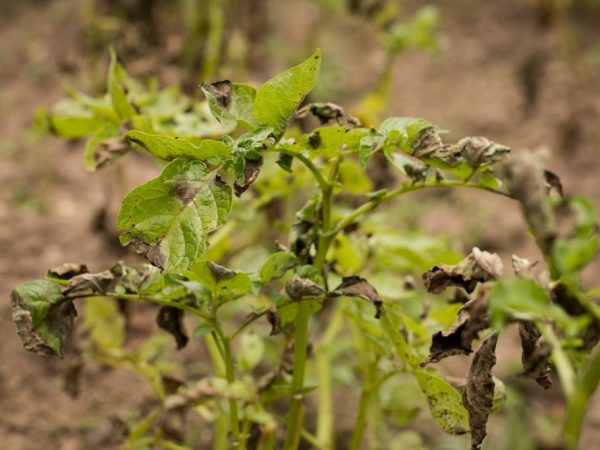Causes of yellowed potato leaves
Yellowed potato leaves - not every gardener gives due attention to this fact, although this is a big mistake. Sometimes there are types of potatoes that naturally have yellow leaves, but they are rare. But, if, nevertheless, they notice such a strange phenomenon, they do not know why the tops of the potato turn yellow.

Causes of yellowed potato leaves
general information
In fact, there are many reasons why potato tops turn yellow. In addition, that this may mean that a disease or parasites attacked the bush, but also the reason for this phenomenon may be a poor habitat, a lack of nutrients, or the ripening time has been disrupted.
The yellowness of potato leaves can be observed at any period of ripening, everything will depend on what caused such a violation. In addition, experts say that if the leaves of a potato turn yellow from below and even before the moment of harvesting, then it is best not to use such fruits in the future for planting.
Some diseases will no longer be cured, so you need to be prepared for the fact that, most likely, you will have to dig up all the fruits and throw them away, and it will not be possible to plant anything in the same land for several years.
Fungus
Often gardeners wonder why the lower leaves of potatoes turn yellow, and then they twist. Most likely, this indicates that a viral fungus attacked the plant.
Fungus is a dangerous disease that is rather difficult to defeat. If the virus is in its last stage and has already infected the plant's root system, then after a few days the entire bush will disappear. Since the disease is viral, it is easily transmitted from bush to bush, therefore, experts recommend that as soon as you see that the bases of the plant turn yellow, it is best to immediately isolate it. This can be done using ordinary film, making a cap out of it. Fungus can refer to different types of diseases. If the foliage immediately turned yellow, then the fungus was already in the seeds.
Phytosporosis
Such an ailment is typical for a young seedling, usually the viral cells of the disease live on the inside of the leaf. In the early stages of the disease, dark brown streaks appear. After that, the bush very quickly begins to dry out and wither.
And the tubers of the plant themselves quickly rot and darken, of course, this significantly affects the percentage of potato yield. In order to save the potato from such a disease, at the very first symptoms, it is necessary to spray the bush with special chemicals against such a disease.
Also, in this case, good sorting of the fruit can help. Also, in order to minimize the chances that the disease will spread to potatoes, it is best to plant those types of vegetables around such fruits that are practically not susceptible to such a disease.
Fusarium
First, the lower leaves of the potato turn yellow, then the middle of the leaf and the top. After a while, the entire bush turns completely yellow.Finding out that a bush is sick is quite difficult, especially in areas that have a too dry and hot climate.
Sometimes such an ailment can cause the main pillar to dry out and it seems that the bush has folded in half, but this is quite rare. Most often, plant seeds are already infected with such a virus. Therefore, immediately after it was planted and the first petals came off, one can understand that the bush is infected, since instead of the usual green color, they are yellow.
Such an ailment can be overcome only if you immediately carry out preventive actions with the seeds of the bush. In addition, so that the disease no longer manifests itself and does not multiply, it is best to burn all the stems immediately after harvesting.
Dry spot
The disease manifests itself through long spots on the leaves, dark in color and on the stems, and these will grow in size over time. And then the bush dries up completely and dies.
The fruits of the bush are significantly reduced in size. This disease must be fought in the same way as with photosporosis.
Ring rot

Disease can ruin crops
Such an ailment appears due to high humidity and high ambient temperatures. The first symptom is that the stem of the bush begins to turn yellow, but at the same time the upper parts of the bush begin to curl and lose their natural color, and then dry and disintegrate.
- If you cut the stem of a bush, you can immediately find rot there, it will resemble a ring, from which the name came - ring rot.
- The big disadvantage of such a disease is the fact that rot affects the fruits, and they all disappear in the ground.
- It is very important to check the seeds and take preventive measures against diseases before planting.
Blackleg
This ailment makes itself felt as soon as you plant the first seeds. In potatoes, the lower leaves turn yellow as soon as they sprout, and then the whole bush and its root system begins to rot.
To prevent this from happening, all tubers that were selected for planting must be treated with a fungicide and left to dry for several days, only after that they can be planted in the ground.
Lack of minerals
Potato leaves can sometimes change their color due to the fact that they lack minerals and nutrients in the soil. The biggest problem that can appear is the shortening of the growing season and, as a result, a significant reduction in the percentage of fruit yield.
Due to the fact that there is not enough calcium, vitamins enter only the stem and remain there, but they do not reach the fruits, and as a result, the tubers do not grow large and this affects the fact that the yield decreases. Often, one stem is responsible for one fruit. That is why, already by the number of stems, you can understand how many fruits you will have on one bush.
In addition, even by the stem you can understand how much the fruit weighs at this moment, although this can be done with some varieties of potatoes. The most important sign of a colossal nitrogen deficiency is when the stem loses its weight and seems to dry out, even with the fact that you water it well and regularly. Wrinkled leaves are also found and strange yellowed spots appear ahead of time.
Viruses
Any viral disease is the most serious and dangerous disease that can only affect potatoes. This can include twisting bolts, alfalfa and curly, and a host of others.
The main symptoms of such diseases are yellow leaves, tubers of which are irregular in shape, a large lag. In addition, after a while, the entire bush can dry out and die.
Usually, plant infection occurs when a diseased bush comes into contact with a healthy plant. The virus can be transmitted both by ground, by air and by real contact.
It is also sometimes found that the virus is transmitted through garden tools or through insects. There is no prevention or cure.The only fight against the disease is to plant only healthy fruits. What you definitely can't do is chemically treat the young shoots.
Insects
Every year, almost every garden suffers from the fact that they are attacked by insects - parasites. Most often, wireworms, potato-type fleas, leafhoppers and others are found.
The most unsafe and scary beetle for vegetable gardens is the Colorado beetle. The female colorado begins to lay its larvae on the inner side of the leaf. Young growth begins to quickly eat the tops, because of this, the plant begins to disappear. First, all the leaves begin to turn yellow, then begin to dry a little, and over time they slowly dry out.
When both larvae and adults begin to work, they can destroy one bush in a few days, sometimes even faster. In order to get rid of such pests, you need to collect and destroy them yourself. Their favorite delicacy is tops.
For protection, you can plant beans or beans around the potatoes. Also, beetles can be poisoned using chemicals that are sold in stores. Green leaves are their favorite delicacy.
Conclusion
There are many reasons why potato leaves can turn yellow. It can be a disease, a lack of vitamins, and viruses. In addition, when the plant does not have enough water, the leaves can also lose their color and change it to a yellow tint or dark brown.
To prevent this from happening in your garden, carefully choose seeds for planting and carry out prevention. Previously, breeders used only folk methods, but today there are a lot of specialized alternative means. Sometimes the leaves can be wrinkled. Most often, yellowing on the leaf is noticed in July.


